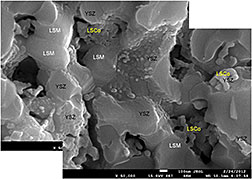- Number 421 |
- September 1, 2014
Advanced manufacturing builds a better fuel cell

Advanced manufacturing techniques can
be used to precisely engineer active sites
architecture in SOFC electrodes.
Solid oxide fuel cells (SOFCs) are uniquely suited to generate clean electric power directly from fossil energy sources with maximum efficiency and with minimal environmental impact. Although SOFC technology developments supported by DOE are improving the technology’s commercial viability, opportunities exist to improve cost and lifetime performance. Increasing cell performance is a key strategy to lowering cell cost, and a critical aspect of improved performance is enhancing the reactions occurring inside the cell. Researchers at DOE's National Energy Technology Laboratory have used a variety of computational techniques and innovative technologies (including fiber-optic sensors and CT scanners) to examine reactions inside SOFCs and pinpoint key reaction locations. Based on this information, researchers have developed a blueprint that enables the application of additive manufacturing techniques to increase cell performance by optimizing the reactions inside SOFCs.
Recently, additive manufacturing—the trade version of 3-D printing—has been revolutionizing the way industry builds parts and components. By allowing machines to construct complex finished products layer by layer directly from computer models, manufacturers have greater freedom in material selection and part configurations. Additive manufacturing techniques are potentially cost-efficient, eliminate material waste, and are much more precise. This precision is a crucial benefit for NETL’s fuel cell researchers, who are using additive manufacturing techniques to engineer special structures inside a SOFC to optimize the location and intensity of the power-producing reactions.
Cathode performance, in particular, can significantly impact the overall performance and cost of a fuel cell system. However, current manufacturing processes limit control over where a fuel cell’s active sites (the sites where reactions occur) will be distributed. To improve cathode efficiency, a technique known as infiltration is used to deposit an electrocatalyst that facilitates reactions and improves the ratio of electricity produced to fuel consumed. Adding the electrocatalyst through infiltration eliminates the structural randomness and places the electrocatalyst where it’s needed most. The engineered structure will significantly improve cathode performance, resulting in reduced cost and a leap closer to the commercial market.
“By controlling the structure through manufacturing, we engineer optimal performance,” says NETL’s Dr. Kirk Gerdes, who leads the Office of Research and Development’s Fuel Cell Research Group. “We can design a super-cathode, but it requires advanced manufacturing processes to produce.” Currently, the most widely used manufacturing technique for fuel cell cathodes is screen printing, which is popular because of its low cost. With screen printing, raw materials are obtained in powder form and liquefied to print the electrode on the cell, much like printing a design onto a t-shirt. While SOFCs produced this way are cheap with uniform size and shape electrodes, the process results in unpredictable and sometimes inconsistent microscopic structure.
To remedy this situation, Dr. Gerdes and his research team are employing advanced, additive manufacturing techniques to engineer more ideal cathode configurations. Their investigations of the internal SOFC structure resulted in complete and detailed 3-D maps of active components, and they are applying that knowledge to determine exactly where the electrocatalyst should be placed for optimal performance. Then, the cathode can be built layer by layer. “A computer model guides introduction of the active structures at the exact location for their optimal functionality so that the networks of solid and gas interfaces are constructed in a sequential way,” Dr. Gerdes explains. “By controlling the manufacturing of the structure, the networks can be better connected for improved efficiency.”
Dr. Gerdes’s team tested this proof-of-concept by manually injecting the catalyst into the cathode. Building on this success, they’re scaling up the experiment and moving it another step closer to industry. Using computer models and a spray coating device to automatically deposit the materials, researchers will deploy the technique to a fuel cell stack obtained from a commercial manufacturer for multiple kilowatt-scale tests. According to Dr. Gerdes, “Using additive manufacturing principles, we have a new technology to significantly improve cathode performance and advance the state of the art. We’re really encouraged by our results.”Submitted by DOE’s National Energy Technology Laboratory
